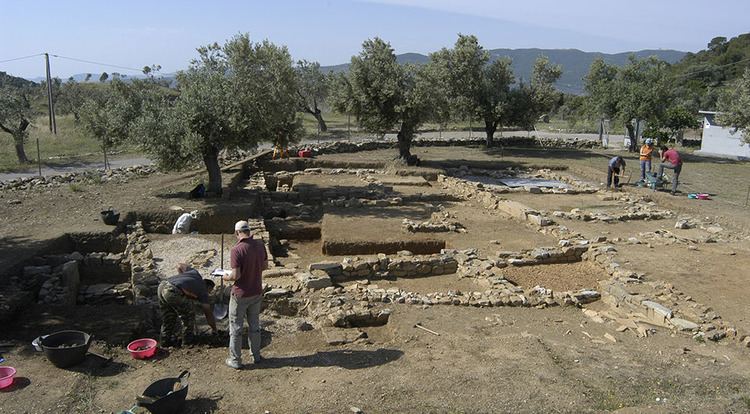 | ||
Kalaureia 1894 ingrid berg
Kalaureia (Ancient Greek: Καλαυρεία) or Calauria or Kalavria (Modern Greek: Καλαυρία) is an island close to the coast of Troezen in the Peloponnesus of mainland Greece, part of the modern island-pair Poros.
Contents
- Kalaureia 1894 ingrid berg
- Map of CE9DCEAECF83CEBFCF82 CEA0CF8CCF81CEBFCF82 Poros 180 20 Greece
- Pre classical asylum
- Legendary amphictyony
- References
Map of %CE%9D%CE%AE%CF%83%CE%BF%CF%82 %CE%A0%CF%8C%CF%81%CE%BF%CF%82, Poros 180 20, Greece
Strabo describes the coastwise journey along the Hermionic Gulf:
"The gulf begins at the town of Asine. Then come Hermione and Troezen; and, as one sails along the coast, one comes also to the island of Calauria, which has a circuit of one hundred and thirty stadia and is separated from the mainland by a strait four stadia wide."Pre-classical asylum
On Calauria a Doric temple of Poseidon was built in the ancient sanctuary, possibly around 520 BCE. The dimensions of the temple are 27.4 by 14.4 m. There are six columns on each short side and twelve on each long side.
There is strong evidence that the epithet of Poseidon at Kalaureia was Geraistos (Γεραιστός), a word from an unknown pre-Hellenic language. A 6th century A.D. dictionary by Stephanus of Byzantium gives the names of Zeus's sons as Geraistos, Tainaros, and Kalauros, who sailed from an unspecified location and landed in different places on the Peloponnesus. Geraistos, Tainaros, and Kalaureia are all sanctuaries of Poseidon; in the towns of the latter two, one of the months of the year was named Geraistios (the only other poleis (πόλεις) with this month name are Sparta, Kalymna, and Kos). It is also theorized that the epithet Geraistios (Γεραίστιος) also applies to Kalaureia because all three sanctuaries function as asylums.
Another, older aetiology of the temple says that it was bartered for by Poseidon himself, who received it from Apollo in exchange for his share of Delphi. This story is attested by Callimachus, Pausanias referencing Musaeus, and Strabo referencing the history of Ephorus. Pausanias and Strabo both quote the following oracle: "For thee it is the same thing to possess Delos or Kalaureia / most holy Pytho [Delphi] or windy Taenarum."
Kalaureia was mentioned by Philostephanus in a lost work On Islands.
It was to Kalaureia that Demosthenes the famous orator, condemned to death with his friends by the pro-Philip Macedonian party at Athens, fled and took sanctuary in Poseidon's sanctuary; as Antipater's officers closed in, he took poison and died, 16 October 322.
Legendary amphictyony
It is claimed by the Hellenistic historian Strabo that in the Archaic period, an early amphictiony, one of several Hellenic leagues of pre-classical times of which little is known, was centered on Kalaureia. Archaeology of the site suggested to Thomas Kelly that the sacred league was founded in the second quarter of the seventh century BCE, ca 680-650; before that date there were virtually no remains at the site, which could not have been used more than sporadically. A peribolos (περίβολος) wall enclosing the sanctuary site was built with the temple, but there are no earlier traces of structures. The temenos or sanctuary dedicated to Poseidon, may have been linked to the sanctuaries at Geraistos and Tainaros (Ταίναρος). The island was known at one time as Eirene (Εἰρήνη) ("Peace"), clearly in reference to the amphictiony. A reference in Strabo gives a list of the poleis that belonged:
And there was also a kind of Amphictyonic League connected with this temple, a league of seven cities which shared in the sacrifice; they were Hermione, Epidaurus, Aegina, Athens, Prasïeis, Nauplïeis, and Orchomenus Minyeius; however, the Argives paid dues for the Nauplians, and the Lacedaemonians for the Prasians." (Strabo, Geography viii.6.14.)Troezen and Poros, which he considered the harbour of Troezen, Strabo omitted. However, there is no archaeological evidence to corroborate this list, and modern scholars believe that a feast in the ancient temenos celebrating the "revival" of the amphictiony, may have been based on a Hellenistic invention; the feast certainly existed: a third-century BCE plaque celebrating the "revival" of the Kalaureian League has been recovered.
After the Greco-Persian Wars, the friendly connection between Athens and Troezen appears to have continued; and during the hegemony of the Athenian empire before the Thirty Years' Peace (455 BCE) Troezen was an ally of Athens, and was apparently garrisoned by Athenian troops; but by this peace the Athenians were compelled to relinquish Troezen. (19.29)
The Sanctuary was excavated by Swedish archaeologists in 1894. Continued excavations from 1997 and onwards by the Swedish Institute in Athens in collaboration with the Greek National Heritage Board.
